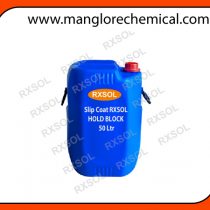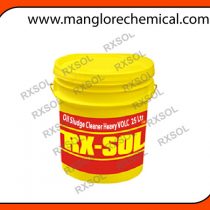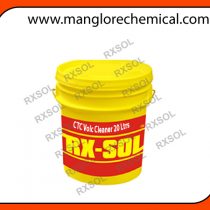Product Name
Hydrazine Hydrate
Product Number
RXSOL-19-1541-010
Company Details:
RX MARINE INTERNATIONAL
105, A wing , BSEL , TECH PARK.
VASHI ,NEW BOMBAY 400703 INDIA
Phone
+91 22 65113333/ 5555 / 9999 / 27611360 / 27815540
Fax
+91 22 2781 1318 :::AOH :0091 9322594669
Email
mail@rxmarine.com
Composition:
Name
CAS #
% by Weight
Hydrazine hydrate
7803-57-8
80
Toxicological Data on Ingredients: Hydrazine hydrate: ORAL (LD50): Acute: 129 mg/kg [Rat]. 83 mg/kg [Mouse]. VAPOR
(LC50): Acute: 570 ppm 4 hour(s) [Rat].
Potential Acute Health Effects:
Extremely hazardous in case of skin contact (corrosive, irritant), of eye contact (irritant), of ingestion, of inhalation. Very hazardous
in case of skin contact (sensitizer, permeator). Liquid or spray mist may produce tissue damage particularly on mucous membranes
of eyes, mouth and respiratory tract. Skin contact may produce burns. Inhalation of the spray mist may produce severe irritation of
respiratory tract, characterized by coughing, choking, or shortness of breath. Severe overexposure can result in death. Inflammation
of the eye is characterized by redness, watering, and itching. Skin inflammation is characterized by itching, scaling, reddening, or, occasionally, blistering.
Potential Chronic Health Effects:
Extremely hazardous in case of skin contact (corrosive, irritant), of eye contact (irritant), of ingestion, of inhalation. Very
hazardous in case of skin contact (sensitizer, permeator). CARCINOGENIC EFFECTS: Not available. MUTAGENIC
EFFECTS: Not available. TERATOGENIC EFFECTS: Not available. DEVELOPMENTAL TOXICITY: Not available. The
substance is toxic to lungs, liver, mucous membranes. Repeated or prolonged exposure to the substance can produce target
organs damage. Repeated or prolonged contact with spray mist may produce chronic eye irritation and severe skin irritation.
Repeated or prolonged exposure to spray mist may produce respiratory tract irritation leading to frequent attacks of bronchial
infection. Repeated exposure to an highly toxic material may produce general deterioration of health by an accumulation in
one or many human organs. Repeated or prolonged inhalation of vapors may lead to chronic respiratory irritation.
Eye Contact:Check for and remove any contact lenses. Immediately flush eyes with running water for at least 15 minutes, keeping eyelids
open. Cold water may be used. Do not use an eye ointment. Seek medical attention.
Skin Contact: If the chemical got onto the clothed portion of the body, remove the contaminated clothes as quickly as possible, protecting
your own hands and body. Place the victim under a deluge shower. If the chemical got on the victim's exposed skin, such as the hands :
Gently and thoroughly wash the contaminated skin with running water and non-abrasive soap. Be particularly careful to clean folds,
crevices, creases and groin. Cold water may be used. If irritation persists, seek medical attention. Wash contaminated clothing before reusing.
Serious Skin Contact: Wash with a disinfectant soap and cover the contaminated skin with an anti-bacterial cream. Seek immediate medical attention.
Inhalation: Allow the victim to rest in a well ventilated area. Seek immediate medical attention.
Serious Inhalation: Evacuate the victim to a safe area as soon as possible. Loosen tight clothing such as a collar, tie, belt or waistband. If breathing is difficult, administer oxygen. If the victim is not breathing, perform mouth-to-mouth resuscitation. WARNING: It may
be hazardous to the person providing aid to give mouth-to-mouth resuscitation when the inhaled material is toxic, infectious or corrosive. Seek immediate medical attention.
Ingestion: Do not induce vomiting. Examine the lips and mouth to ascertain whether the tissues are damaged, a possible indication
that the toxic material was ingested; the absence of such signs, however, is not conclusive. Loosen tight clothing such as a collar, tie,
belt or waistband. If the victim is not breathing, perform mouth-to-mouth resuscitation. Seek immediate medical attention.
Serious Ingestion: Not available.
Flammability of the Product: Combustible.
Auto-Ignition Temperature: Not available.
Flash Points: OPEN CUP: 72°C (161.6°F) (Cleveland).
Flammable Limits: LOWER: 4.7%
Products of Combustion: Not available.
Fire Hazards in Presence of Various Substances: Flammable in presence of open flames and sparks, of oxidizing materials.
Explosion Hazards in Presence of Various Substances:
Risks of explosion of the product in presence of mechanical impact: Not available. Risks of explosion of the product in presence of static discharge: Not available. Explosive in presence of metals.
Fire Fighting Media and Instructions:
SMALL FIRE: Use DRY chemical powder. LARGE FIRE: Use water spray, fog or foam. Do not use water jet.
Special Remarks on Fire Hazards: Not available.
Special Remarks on Explosion Hazards: Not available.
Small Spill: Dilute with water and mop up, or absorb with an inert dry material and place in an appropriate waste disposal container.
Large Spill: Combustible material. Corrosive liquid. Keep away from heat. Keep away from sources of ignition. Stop leak if without risk. Absorb with DRY earth, sand or other non-combustible material. Do not get water inside container. Do not touch spilled material. Use water spray curtain to divert vapor drift. Prevent entry into sewers, basements or confined areas; dike if needed. Eliminate all ignition sources. Call for assistance on disposal.
Precautions: Keep locked up Keep container dry. Keep away from heat. Keep away from sources of ignition. Ground all equipment containing material. Do not ingest. Do not breathe gas/fumes/ vapour/spray. Never add water to this product In case of insufficient ventilation, wear suitable respiratory equipment If ingested, seek medical advice immediately and show the container or the label. Avoid contact with skin and eyes Keep away from incompatibles such as oxidizing agents, metals, acids, moisture.
Storage: Flammable materials should be stored in a separate safety storage cabinet or room. Keep away from heat. Keep away from sources of ignition. Keep container tightly closed. Keep in a cool, well-ventilated place. Ground all equipment containing material. Keep container dry. Keep in a cool place.
Engineering Controls:
Provide exhaust ventilation or other engineering controls to keep the airborne concentrations of vapors below their respective threshold limit value. Ensure that eyewash stations and safety showers are proximal to the work-station location.
Personal Protection:
Face shield. Full suit. Vapor respirator. Be sure to use an approved/certified respirator or equivalent. Gloves. Boots.
Personal Protection in Case of a Large Spill:
Splash goggles. Full suit. Vapor respirator. Boots. Gloves. A self contained breathing apparatus should be used to avoid inhalation of the product. Suggested protective clothing might not be sufficient; consult a specialist BEFORE handling this product.
Exposure Limits: Not available.
Physical state and appearance
Liquid.
Odor
Not available.
Taste
Not available.
Molecular Weight
50.06 g/mole
Color
Not available.
pH (1% soln/water)
Not available.
Boiling Point
113.5°C (236.3°F)
Melting Point
-51.7°C (-61.1°F)
Critical Temperature
Not available.
Specific Gravity
1 (Water = 1)
Vapor Pressure
Not available.
Vapor Density
1.1 (Air = 1)
Volatility
Not available.
Odor Threshold
Not available.
Water/Oil Dist. Coeff
Not available.
Ionicity (in Water)
Not available.
Dispersion Properties
See solubility in water, methanol.
Solubility
Easily soluble in cold water, hot water. Soluble in methanol. Insoluble in diethyl ether.
Stability: The product is stable.
Instability Temperature: Not available.
Conditions of Instability: Not available.
Incompatibility with various substances:
Extremely reactive or incompatible with oxidizing agents, metals, acids. Reactive with moisture.
Corrosivity: Non-corrosive in presence of glass.
Special Remarks on Reactivity:
Decomposes on heating. Explodes in presence of bromine trifluoride. Explosion hazard. Forms explosive mixtures in air. May
explode when heated. Reacts violently with iodine monochloride. Reacts violently with iodine pentachloride.
Special Remarks on Corrosivity: Not available.
Polymerization: No.
Routes of Entry: Dermal contact. Eye contact. Inhalation. Ingestion.
Toxicity to Animals:
WARNING: THE LC50 VALUES HEREUNDER ARE ESTIMATED ON THE BASIS OF A 4-HOUR EXPOSURE. Acute oral toxicity (LD50): 83 mg/kg [Mouse]. Acute toxicity of the vapor (LC50): 570 ppm 4 hour(s) [Rat].
Chronic Effects on Humans: The substance is toxic to lungs, liver, mucous membranes.
Other Toxic Effects on Humans:
Extremely hazardous in case of skin contact (corrosive, irritant), of ingestion, of inhalation. Very hazardous in case of skin contact (sensitizer, permeator).
Special Remarks on Toxicity to Animals: Not available.
Special Remarks on Chronic Effects on Humans: Animal embryotoxic.
Special Remarks on other Toxic Effects on Humans: Not available.
Ecotoxicity: Not available.
BOD5 and COD: Not available.
Products of Biodegradation:
Possibly hazardous short term degradation products are not likely. However, long term degradation products may arise.
Toxicity of the Products of Biodegradation: The products of degradation are less toxic.
Special Remarks on the Products of Biodegradation: Not available.
Waste Disposal:
DOT Classification: CLASS 8: Corrosive liquid.
Identification: : Hydrazine, hydrate : UN2030 PG: II
Special Provisions for Transport: Not available.
Federal and State Regulations:
California prop. 65: This product contains the following ingredients for which the State of California has found to cause cancer, birth defects or other reproductive harm, which would require a warning under the statute: Hydrazine hydrate California prop. 65: This product contains the following ingredients for which the State of California has found to cause cancer which would require a warning under the statute: Hydrazine hydrate TSCA 8(b) inventory: Hydrazine hydrate SARA 302/304/311/312 extremely hazardous substances: Hydrazine hydrate
Other Regulations: OSHA: Hazardous by definition of Hazard Communication Standard (29 CFR 1910.1200).
Other Classifications:
WHMIS (Canada):
CLASS B-3: Combustible liquid with a flash point between 37.8°C (100°F) and 93.3°C (200°F). CLASS D-1A: Material causing immediate and serious toxic effects (VERY TOXIC). CLASS D-2A: Material causing other toxic effects (VERY TOXIC). CLASS
E: Corrosive liquid.
DSCL (EEC):
R23/25- Toxic by inhalation and if swallowed. R35- Causes severe burns. R43- May cause sensitization by skin contact.
HMIS (U.S.A.):
Health Hazard: 3
Fire Hazard: 2
Reactivity: 2
Personal Protection:
National Fire Protection Association (U.S.A.):
Health: 3
Flammability: 2
Reactivity: 2
Specific hazard:
Protective Equipment:
Gloves. Full suit. Vapor respirator. Be sure to use an approved/certified respirator or equivalent. Wear appropriate respirator
when ventilation is inadequate. Face shield.
The information above is believed to be accurate and represents the best information currently available to us. However, we make no warranty of merchantability or any other warranty, express or implied, with respect to such information, and we assume no liability resulting from its use. Users should make their own investigations to determine the suitability of the information for their particular purposes. In no event shall ScienceLab.com be liable for any claims, losses, or damages of any third party or for lost profits or any special, indirect, incidental, consequential or exemplary damages, howsoever arising, even if ScienceLab.com has been advised of the possibility of such damages.
|







Reviews
There are no reviews yet.